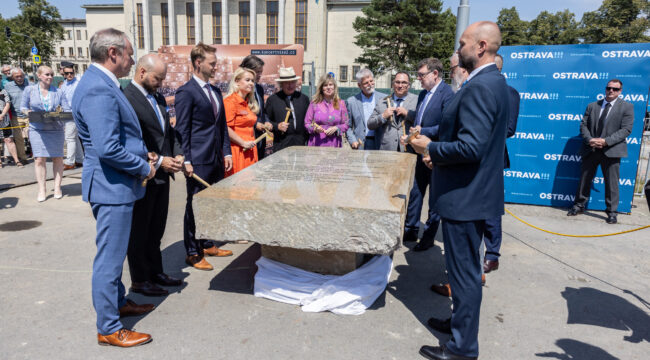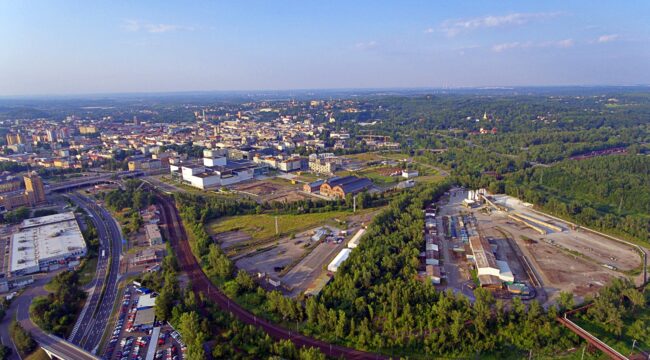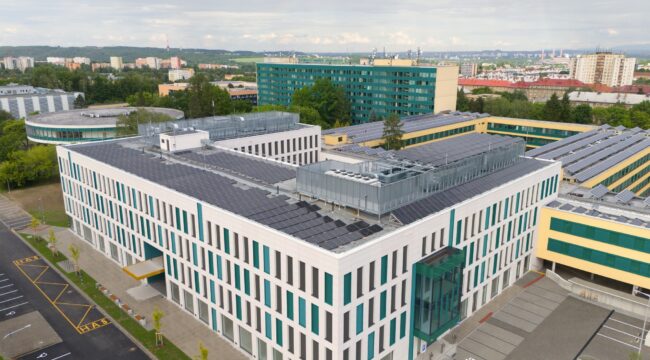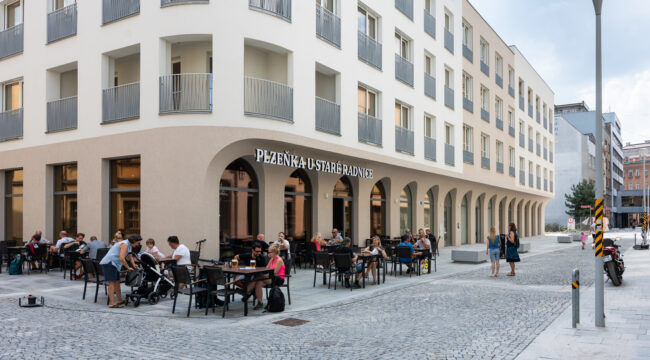A crucial step on the way to a Concert Hall for Ostrava
The construction of the new concert hall, which combines the reconstruction of the heritage-protected House of Culture of the city of Ostrava with the timeless new construction of the concert hall and the use of the most modern green technology, has indeed reached a historical milestone. On July 19, 2024, a symbolic laying of the foundation stone for this unique construction took place with the participation of the President of the republic Petr Pavel, mayor of Ostrava Jan Dohnal, governor Josef Bělica, distinguished world architect Steven Holl, and other city and state representatives.
The aforementioned ceremony was preceded by a performance by the Janáček Philharmonic Orchestra of Ostrava under the baton of the future chief conductor Daniel Raiskin, which played the symphonic poem Vltava from Bedřich Smetana’s Má vlast (My homeland) cycle.
“A building, which is exceptional in many respects, has already required a considerable amount of preparation time from a whole range of specialists; however, a wide spectrum of work is still needed to realize the project itself in in the years to come. The reward for us and future generations will be a multifunctional complex unique to the country, offering top-notch acoustics for musical productions, a venue for theatre performances, education, and other leisure activities. The much-discussed architectural design by Steven Holl and his team is a significant benefit not only for the city, placing the building among global unique projects also thanks to the method of processing, which specifically encompassed the necessary reconstruction of a listed building and complemented it with a truly visionary solution for the new concert hall. The project’s benefits in the fields of culture and architecture are indisputable,” stated Jan Dohnal, the mayor of Ostrava.
The new building may be become one of the most ecological buildings in the country, it has considerable solar potential. The use of natural light, glass walls, and skylights will provide the building with ample daylight, reducing its dependence on non-renewable energy sources. Another way to minimize the environmental impact on the surroundings is through the chosen heating and cooling systems. Water features near the building will also partially utilize rainwater. In 2021, the project was ranked among the ten most anticipated buildings in the world by the prestigious American magazine Architizer.
The new building will become another landmark of the city of Ostrava, encompassing not only a concert hall with perfect acoustics but also a comprehensive musical, cultural, production, and educational facility. The building will feature a large hall with a capacity for 1,300 visitors and will also provide facilities for the Janáček Philharmonic Orchestra Ostrava. Some of the 490 seats in the theatre hall will also be available to visitors as well as the chamber hall with 515 seats. In addition, the building also includes an educational centre with a capacity of 200 seats and a recording studio of world standards. The project also incorporates spaces for leisure activities, a restaurant, a café, lounges, and other amenities.
“This is an extremely exciting moment for Czech music and architecture. The new concert hall in Ostrava, a ‘perfect acoustic instrument in its case,’ which was created on the basis of working drawings, will now take shape in real space and with real sound. It will become an inspiring place for the public and international visitors, building on Ostrava’s rich musical legacy and allowing the city to make its mark on the global music map,” stated Steven Holl.
The auditorium of the large hall is arranged in the so-called vineyard style, divided into smaller sections, with part of the auditorium even behind the stage. The sufficiently steep arrangement ensures good visibility, and practical terraces enhance the feeling of intimacy. The furthest seats are expected to be situated about 28 meters from the stage. A sound reflector, designed to reflect sound with an ideal time delay for both musicians and the audience in close proximity to the stage, will be suspended 15 meters above the stage. The high-quality sound is enhanced by the maple wood panelling, which is used, among other things, to make violins. Rectangular views fine-tune the acoustics on stage, allowing musicians to hear themselves and their fellow performers. Right-angle views tune the acoustics on stage so that musicians can hear themselves and their fellow musicians.
The design and corresponding acoustic adjustments of the concert hall were entrusted to the renowned expert Yasuhisa Toyota. His company, Nagata Acoustics, has provided acoustic solutions for nearly 60 concert halls around the world since 1971. An acoustic model of the concert hall’s interior, built to a 1:10 scale to address the technical parameters of acoustics, was manufactured by the company Aveton in Mnichovo Hradiště, based on specifications from Nagata Acoustics.
“The ground-breaking ceremony, attended by the head of state and other top constitutional officials and city representatives, is a beacon of hope not only for the Janáček Philharmonic Ostrava but for the entire cultural scene in the Czech Republic. It is a hope that culture and cultural activities are no longer seen as peripheral issues. The hope that we are aware of the fact that culture is what defines us as human beings, but especially as a nation” concluded Jan Žemla, director of the Janáček Philharmonic Ostrava.
The construction will be financed with the financial support of a grant from the European Commission, a loan from the European Investment Bank, subsidies from the Ministry of Culture of the Czech Republic and the Moravian-Silesian Region. The city is simultaneously preparing applications for subsidies from other potential funding sources and is saving into its designated fund for financing the concert hall, which currently amounts to CZK 570 million.
“The new concert hall, which combines the renovated building of the City Culture House in Ostrava with a modern new structure, will undoubtedly be one of the most intriguing architectural achievements in the wider region and aspires to become an icon of Ostrava. I believe it will enhance cultural opportunities not only for the city’s residents, but also for domestic and international tourists, who are increasingly interested in artistic and festival productions held in Ostrava and its surrounding areas. I am pleased that the state has contributed to the construction through the Ministry of Culture with an amount of 600 million Czech crowns,” stated Zbyněk Stanjura, Minister of Finance.
Ostrava has already attempted to build a concert hall six times, for the first time in the second half of the 19th century. The City Culture House of Ostrava has been a cultural monument since 2004, built according to the design by Jaroslav Fragner between 1956 and 1961, and was ceremonially opened during that period. In 2018, an international architectural competition was held with 34 architectural studios participating. A year later, the winning design of Steven Holl Architects from New York and Architecture Acts from Prague was announced. Steven Holl drew inspiration for the concert hall from the work of the composer Leoš Janáček.
The construction study was completed in 2020 and included the renovation of the existing cultural house. This was followed by site exploration, the creation of an acoustic model, and the relevant administrative processes, including applying for joint zoning approval and building permits. A tender was announced for the contractor of the construction works. The first phase, involving site preparation, commenced last year. In early 2024, the contractor for the second phase was selected, namely the Consortium for the Concert Hall, composed of IMOS Brno a.s. and IPS Třinec a.s. Five bidders sought to build the new city landmark, with the winning company offering the lowest bid of CZK 2.798 billion. Over the coming months, excavation of the construction pit will take place, with completion scheduled for November 2024. The estimated completion date for the project is now in 2027. Further details can be found at https://www.koncertnisal.cz/.
However, the entire affected area of Ostrava is set for significant transformation. The project will connect the concert hall with the city’s avenue 28. října. The city is also undertaking the construction of a new parking garage with a capacity of up to six hundred parking spaces, and changes are also planned for the adjacent Dr. Milada Horáková Park. In close proximity to the hall, the Moravian-Silesian Region will construct a scientific library known as the “Black Cube.” “Thanks to all these projects, the immediate vicinity of the county council will soon undergo a substantial transformation. The regional government will be located in a prestigious area that will have a global impact, not only architecturally. It is expected that the concert hall will become a sought-after venue for top artists. The Black Cube, serving as a centre for digitization, science, and innovation, will attract visionaries, students, and all who are passionate about the latest technologies and innovations, where education is part of their lifestyle,” concluded Josef Bělica, Governor of the Moravian-Silesian Region.

American architect Steven Holl is one of the most renowned architects of today. In 1977, he found Studio Steven Holl Architects, which has gained international recognition with numerous works, including museums, residential complexes, and student dormitories. Steven Holl is an advocate for environmental sustainability and promotes green roofs, recycling, and the use of geothermal energy in most of his projects. His water purification plant project in Hamden, Connecticut, featuring the largest green roof in the state at 2,800 square meters, was included in the Top 10 Green Projects of 2007 by the American Institute of Architects Committee on the Environment.




